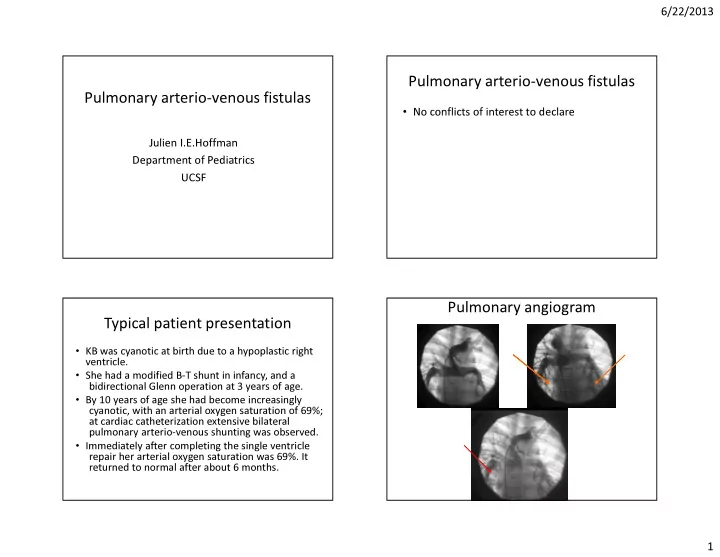

6/22/2013 Pulmonary arterio-venous fistulas Pulmonary arterio-venous fistulas • No conflicts of interest to declare Julien I.E.Hoffman Department of Pediatrics UCSF Pulmonary angiogram Typical patient presentation • KB was cyanotic at birth due to a hypoplastic right ventricle. • She had a modified B-T shunt in infancy, and a bidirectional Glenn operation at 3 years of age. • By 10 years of age she had become increasingly cyanotic, with an arterial oxygen saturation of 69%; at cardiac catheterization extensive bilateral pulmonary arterio-venous shunting was observed. • Immediately after completing the single ventricle repair her arterial oxygen saturation was 69%. It returned to normal after about 6 months. 1
6/22/2013 Detecting anatomic intra-pulmonary Injection of agitated saline into LPA shunts 1. IV/PA injection of radio-labeled macro-aggregated albumin ( 99 mTCMAAA). Very sensitive, but results vary with particle Before size. Quantifiable. 2. Contrast echocardiography. Sensitive, cannot quantify exactly 3. Pulmonary angiography: Blush due to increased number of tiny vessels May show details of fistulae. Much less sensitive than first two methods After 4. Measure AaD while breathing 100% oxygen Normal venous admixture Diseases with abnormal venous admixture • After Glenn, Kawashima, or Fontan operations • Contrast echocardiography – More with Kawashima, but may be absent – Usually none at rest, may appear with exercise • Rarely in congenital cardiovascular diseases without surgery • Respiratory gas techniques • Isolated pulmonary arterio-venous fistulas, especially with hereditary hemorrhagic telangiectasia (Osler-Weber-Rendu – Shunt of 3-5% of cardiac output with heavy syndrome) exercise • Liver disease (hepato-pulmonary syndrome) • Radiolabeled microspheres – <6% of cardiac output • Are there any common factors? 2
6/22/2013 Post-surgical pulmonary arterio-venous fistulas Possible mechanisms • Occur in >50% of subjects after Glenn or Kawashima operations • Decrease or absence of inferior vena caval return to lungs, depending on lesion and operation • Incidence increases with time • In original Glenn, fistulas only on side of operation • Decreased pulsatility-unlikely because fistulas usually • In bidirectional Glenn or Kwashima operations fistulas are bilateral disappear after completing the Fontan • Fistulas usually disappear after completing the Fontan operation • In Kawashima operation only hepatic venous return does not go directly to the lungs.Therefore likely that exclusion of hepatic venous drainage i s responsible Hepatic factors in pulmonary arterio- CHD without surgery venous fistulas 1. Pulmonary arterio-venous fistulas rare • Pulmonary arterio-venous fistulas are often in CHD associated with failure of hepatic vein blood to perfuse lungs in first circulation 2. Occasionally with left atrial isomerism • These fistulas usually disappear when hepatic 3. Isolated drainage of IVC or hepatic venous blood is re-routed to lung, including veins to left atrium Fontan patient with hepatic blood flow directed almost exclusively to one lung • Suggests a deficiency of a short-lived anti- angiogenic factor or an excess of a short-lived angiogenic factor 3
6/22/2013 Isolated pulmonary arterio-venous Putative hepatic factor fistulas • Uncommon to present in childhood • Sometimes plexiform lesions • Sometimes large aneurysms • Usually associated with Hereditary Hemorrhagic Telangiectasia (HHT) Lessons from HHT Importance of HHT Natural equilibria in body: 1. Many cells and molecules undergo replacement after characteristic times -120 days for red blood cells, 5 days for myosin. Control systems regulate the balance between formation and destruction 2. Equilibrium may be static until disturbed e.g blood pro- and anti-coagulant activity One of these may be true for lung blood vessels, with balanced angiogenesis and anti-angiogenesis related to endoglin and ALK1. 4
6/22/2013 Hepato-pulmonary syndrome ? • Defined as “an arterial oxygenation defect induced by • Are mechanisms of Glenn and Kawashima intrapulmonary vascular dilatations (IPVD) associated with hepatic pulmonary arterio-venous fistulas similar to those disease” for hepato- pulmonary syndrome? • Occurs in any liver disease, mainly cirrhosis (in 15-30%) • Pathology characterized by hugely dilated capillaries as well as • Is diseased liver producing excess angiogenic factor pulmonary arterio-venous fistulas. Cyanosis due to diffusion defect or decreased anti-angiogenic factor? as well as Va/Q mismatch and fistulas • Lung contains CD68(+) macrophages that produce VEGF and PDGF Angiotensin Possible factors • VEGF and endoglin produced by many cells and tissues • VEGF increased in cyanotic heart disease • Angiopoietin-1 widely produced by pericytes and smooth muscle cells, angiopoietin-2 inendothelial cells • Angiostatin is produced from plasminogen in the liver, but half-life is 15 min • Endostatin is produced from soluble collagen XVIII from liver, but has long half-life. Cannot be dismissed because of recent finding that endostatin decreases and collagen XVIII increases after Glenn operation 5
6/22/2013 Angiogenesis 1 Angiogenesis 2 Angiogenesis 3 Angiogenesis 4 6
6/22/2013 Angiogenesis 5-7 Conclusions • Hepatic factor affected by first pass circulation in the lungs – Excess of antiogenic factor(s) – Deficit of anti-angiogenic factor(s) • With multiplicity of factors involved in angiogenesis, it would not be surprising to find more than one factor involved • Whether the involved factor produces pulmonary arterio-venous fistulas may depend on concentrations of other involved factors Venous admixture 1. Produces an Alveolar-arterial gradient (AaD) of oxygen tension 2. Normal AaD 5-15 mm Hg; more in neonates 3. Usually <5% of cardiac output 4. Causes of increased AaD: a. Va/Q mismatch-abolished by breathing 100% oxygen THE END b. Diffusion limitation-does not occur normally c. Lesions excluding air from alveoli-collapse, fluid, cells d. Anatomic connections that by-pass alveoli Post-alveolar connections Bronchial veins Thebesian veins Pre-alveolar connections-pulmonary arterio-venous fistulas 7
6/22/2013 Basic diagram of venous admixture Non-functional alveolus Pathology of fistulas • Inadequately described • Usually irregular thin walled vessels, especially subpleurally • NB. In hepato-pulmonary syndrome – the pulmonary capillaries are very dilated, unlike other diseases mentioned here – There are CD68+ macrophages that release angiogenic factors 8
Recommend
More recommend